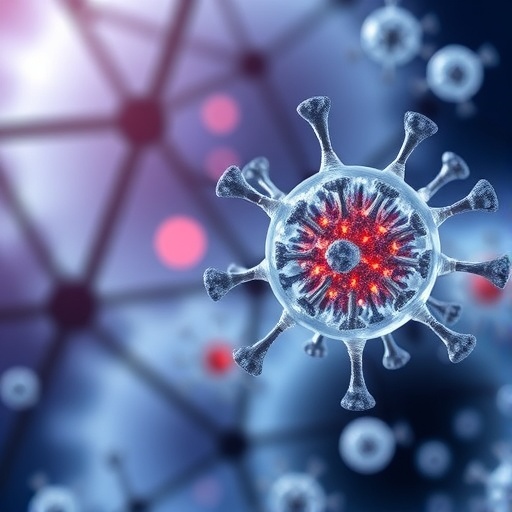In a groundbreaking study, researchers have unveiled a transformative approach harnessing the power of single-cell sequencing and machine learning to explore the intricate landscape of lung adenocarcinoma (LUAD). The escalating incidence of this malignancy calls for innovative strategies to decipher the cellular dynamics within the tumor microenvironment, a critical determinant of cancer progression and patient prognosis. The study integrates high-dimensional omics data with sophisticated computational methods, marking a significant leap in our understanding of immune responses in tumors.
Lung adenocarcinoma remains one of the leading causes of cancer-related mortality globally. Despite advancements in targeted therapies and immunotherapies, the heterogeneity inherent in tumors poses a formidable challenge. Traditional bulk-tissue analyses often obscure the complexities of cellular interactions and microenvironmental influences at the single-cell level. This investigation alleviates these challenges by employing a comprehensive integrative framework that elucidates the relationship between immunogenic cell death and tumor progression.
The novel methodology foregrounds single-cell RNA sequencing, a technology that enables researchers to capture the transcriptomic profiles of individual cells. This level of granularity reveals variations in gene expression that can elucidate the mechanisms underpinning tumor growth and resistance. The combination of this technology with machine learning algorithms allows for the accurate classification of cellular populations, providing insights into immune cell infiltration and the tumor microenvironment’s spatial architecture.
Central to the study is the concept of immunogenic cell death (ICD). Understanding how cancer cells elude immune detection is paramount for developing effective therapeutic strategies. The researchers meticulously examined the signals associated with ICD, focusing on how certain cancer cell death pathways generate a robust immune response. Their findings suggest that the tumor microenvironment can facilitate or impede these immunogenic signals, ultimately determining the effectiveness of immunotherapy treatments.
As the researchers delved deeper into the tumor microenvironment, they highlighted the importance of cellular interactions. Their work illuminated how cancer-associated fibroblasts (CAFs) and immune cells communicate within the LUAD context. By leveraging advanced imaging techniques, they visually represented the spatial distribution of these cellular players, which has profound implications for our understanding of tumor biology and therapeutic interventions.
Machine learning played a pivotal role in the interpretation of the enormous datasets generated from the single-cell RNA sequencing. The researchers applied several algorithms to discern patterns within the data, predicting the responsiveness of different tumor microenvironments to specific therapeutic agents. This predictive modeling serves as a prelude to personalized medicine, where treatments can be tailored based on individual tumor profiles.
In addition to focusing on the tumor cells, the team also scrutinized the immune landscape, identifying various immune cell subsets and their functional states. Solving the riddle of immune evasion by LUAD is critical, and this research offers new avenues through which to boost anti-tumor immunity. The analysis provided a clear depiction of how immune-suppressive pathways can be targeted to augment the efficacy of existing therapies.
The conclusions drawn from this extensive analysis of LUAD underscore the necessity for a paradigm shift in cancer research methodologies. By embracing integrative approaches that synthesize cellular-level data with comprehensive bioinformatics, new therapeutic strategies can emerge. The implications of this study reverberate through the oncology community, emphasizing the need for continued innovation in the understanding of cancer pathophysiology.
One of the remarkable outcomes of this research is the establishment of a detailed atlas of the LUAD microenvironment. This atlas serves not only as a reference for future studies but also as a vital tool for clinicians aiming to improve patient outcomes through more targeted therapies. This evolution in our understanding of tumor biology is poised to change the way oncologists manage lung cancer treatment.
Furthermore, the integration of computational biology and wet lab experimentation paves the way for exciting interdisciplinary collaborations. Such partnerships could streamline the drug discovery process, ensuring that promising candidates are nourished by both biological insights and computational rigor. The synergy between these fields enhances the efficacy of translational research, catalyzing breakthroughs that were once thought implausible.
The researchers are optimistic that their findings will spur further investigation into other cancer types. The methodology they developed holds the potential to uncover universal mechanisms of immune evasion and therapeutic resistance. It could also catalyze a new wave of research that capitalizes on machine learning to explore the complexities of cancer biology across various histologies.
In summary, this formative research reiterates the importance of interdisciplinary approaches to tackle one of humanity’s most challenging health crises. The insights gleaned from this study not only shed light on LUAD’s complexity but also align with the broader narrative of precision medicine. By continuing to bridge the gap between single-cell technologies, machine learning, and clinical applications, there exists a genuine promise of more effective, personalized treatments that could one day transform cancer care.
As we await further clinical validation of these findings, the research community stands encouraged by the potential that exists at the intersection of technology and biology. The future of cancer treatment may rely heavily on these innovative solutions as we strive towards a future where cancer is no longer an insurmountable battle but rather a condition that can be managed with precision and insight.
Subject of Research: The immune response in lung adenocarcinoma and its relationship with tumor microenvironment using single-cell sequencing and machine learning.
Article Title: Integrative single-cell and machine learning approach to characterize immunogenic cell death and tumor microenvironment in LUAD.
Article References: Zhang, H., Mu, Q., Jiang, Y. et al. Integrative single-cell and machine learning approach to characterize immunogenic cell death and tumor microenvironment in LUAD. J Transl Med 23, 1000 (2025). https://doi.org/10.1186/s12967-025-06889-2
Image Credits: AI Generated
DOI: 10.1186/s12967-025-06889-2
Keywords: Lung adenocarcinoma, single-cell sequencing, machine learning, immunogenic cell death, tumor microenvironment, cancer, precision medicine.




